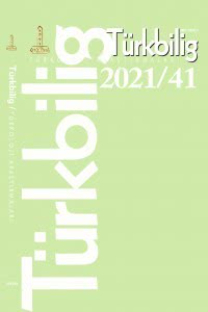Kanıtsallık Kategorisi Açısından -DI Biçimbirimi
Bu çalışmanın amacı, Türkiye Türkçesinde -DI biçimbiriminin kullanıldığı bağlamları kanıtsallık kategorisi açısından incelemektir. Kanıtsallık açısından işaretsiz olduğu bilinen -DI biçimbiriminin, olayın doğrudan gözlendiği, sadece olgu olarak ortaya konduğu ya da kanıtsallık ayrımının gerekli görülmediği durumlarda kullanılabildiği bilinmektedir. -DI işaretleyicisinin alışkanlık ve tecrübelere bağlı olarak dolaylı yoldan edinilen bilgiden emin olma oranının yüksek olduğu durumlarda da kullanıldığı tespit edilmiştir. Bir çocuğun, babasının her akşam aynı saatlerde eve geldiğini bildiği için zil çaldığında “babam geldi” diyerek kapıya koşması bu kullanıma örnek gösterilebilir. Konu, standart Türkiye Türkçesi örneğinde ele alınacaktır. Çalışmanın sonuçları, -DI biçimbiriminin, bilgi kaynağının hangi türleriyle, hangi söylem ve bağlamlarda kullanıldığını ortaya koyacaktır.
Anahtar Kelimeler:
Kanıtsallık, Dolaylılık, Türkiye Türkçesi, Görülen Geçmiş Zaman
-DI Morpheme in terms of Evidentiality
The aim of this paper is to analyse the contexts used in -DI morpheme in terms of evidentiality in modern Turkish. -DI morpheme is unmarked member of the evidential category. It’s known that -DI is used in the cases of direct observation, an event is presented as a fact or the speaker considers the evidential distinction unnecessary. During our work, it has been found that -DI morpheme is used when the speaker is confident about the indirect information obtained depending on the habits and experiences, too. We can give the situation as an example in which a child runs to the door when the bell rings saying that “Babam geldi” (My father has come) since he/she knows that his/her father comes home every evening at the same time. The subject will be discussed in modern Turkish examples. This paper’s results will reveal which types of information sources, discourses and contexts -DI morpheme is used in.
Keywords:
Evidentiality, Indirectivity, Turkish, Definite Past Tense,
___
- AKSU-KOÇ, Ayhan (2000). Some Aspects of the Acquisition of Evidentials in Turkish. In Evidentials Turkic, Iranian and Neigbouring Languages (pp. 15-28). New York: Mouton de Gruyter.
- ASLAN DEMİR, Sema (2013). Türkmencede Kanıtsallık/Evidensiyellik. Leyla Karahan Armağanı içinde (pp. 409-420). Ankara: Akçağ Yayınları.
- ASLAN DEMİR, Sema (2014). Türkmencede eken (Demir, N. - Karakoç, B. - Menz, A. Ed.). In Turkology and Linguistics, Éva Ágnes Csató Festschrift (pp. 21-30). Ankara: Hacettepe Üniversitesi Yayınları.
- BENZER, Ahmet (2008). Fiilde Zaman, Görünüş, Kip ve Kiplik. Doktora Tezi. Marmara Üniversitesi, Eğitim Bilimleri Enstitüsü. İstanbul.
- de HAAN, F. (1999). “Evidentiality and Epistemic Modality: Setting Boundaries”. Southwest Journal of Linguistics, 18: 83-101.
- DEMİR, Nurettin (2003). “On imiş in Cypriot Turkish”. Turkic Languages, VII, 268-274.
- DEMİR, Nurettin (2012). “Türkçede Evidensiyel”. bilig, 62: 97-118.
- DOĞAN, Talip (2018). “Horasan Türkçesinin Bocnurd Ağzında Kanıtsallık (Evidentiality)”. SUTAD, 44: 1-14.
- FRIEDMAN, Victor A. (1978). On the Semantic and Morphological Influence of Turkish on Balkan Slavic. (Farkas, D. - Jacobsen, W. M. - Todrys, K. W. Ed.). In Papers from the Fourteenth Regional Meeting: Chicago Linguistic Society (pp. 108-118). Chicago: Chicago Linguistic Society.
- HİRİK, Seçil (2014). Türkiye Türkçesinde Bilgi Kiplikleri. Doktora Tezi. Kırıkkale Üniversitesi, Sosyal Bilimler Enstitüsü. Kırıkkale.
- HİRİL, Seçil (2015). “Türkçede Bağımlı-Biçimbirimsel Kipliklerin Çok İşlevliliği Üzerine”. International Journal of Languages’ Education and Teaching. UDES 2015: 2395-2409.
- JOHANSON, Lars (2003). Evidentiality in Turkic (Aikhenvald, A. Y. - Dixon, R. M. W. Ed.). In Studies in Evidentiality (pp. 273-290). Amsterdam, Philadelphia: Benjamins.
- JOHANSON, Lars (2014). Türkçe Dil İlişkilerinde Yapısal Etkenler (Çev.: Nurettin Demir). Ankara: TDK Yay.
- KERİMOĞLU, Caner (2011). Kiplik İncelemeleri ve Türkçe. İzmir: Dinozor Kitabevi.
- KILIÇ, Filiz (2005). “Kırgız Türkçesinde Algısal Delile Dayalılık”. Modern Türklük Araştırmaları Dergisi, II, 1: 68-113.
- KIRAL, Filiz (2000). Reflections on -miš in Khalaj. (Johanson, L. - Utas, B. Ed.). In Evidentials. Turkic, Iranian and Neighbouring Languages (pp. 89-101). Berlin, New York: Mouton de Gruyter.
- LAZARD, Gilbert (2001). “On the Grammaticalization of Evidentiality”. Journal of Pragmatics, 33: 359-367.
- MEHMET, Gülsün (2012). “Delile Dayalılık ve Salar Türkçesinde Öge Cümlelerle Delillendirilmiş Dolaylılık”. Dil Araştırmaları, 11: 67-80.
- MENZ, Astrid (2000). Indirectivity in Gagauz. (Johanson, L. - Utas, B. Ed.) In Evidentials. Turkic, Iranian and Neighbouring Languages (pp. 103-114). Berlin, New York: Mouton de Gruyter.
- PALMER, F. R. (2001). Mood and Modality. New York: Cambridge University Press.
- PLUNGIAN, V. A. (2010). Types of Verbal Evidentiality Marking: an Overview. (Diewald, G. - Smirnova, E. Ed.). In Linguistic Realization of Evidentiality in European Languages (pp. 15-58). Berlin/New York: Walter de Gruyter.
- RIND-PAWLOWSKI, Monika (2014). “Text Types and Evidentiality in Dzungar Tuvan”. Turkic Languages, 18: 159-188.
- SLOBIN, D. I. ve Aksu, A. (1982). Tense, Aspect and Modality in the Use of the Turkish Evidential. (P. J. Hopper Ed.). In Tense, Aspect: Between Semantics and Pragmatics (pp. 185-200). Amsterdam: John Benjamins.
- STRAUGHN, Christopher A. (2011). Evidentiality in Uzbek and Kazakh. Phd Dissertation. The University of Chicago. Chicago, Illinois.
- WILLETT, Thomas (1988). “A Cross-linguistic Survey of the Grammaticalization of Evidentiality”. Studies in Language, 12/1: 51-97.
- ISSN: 1302-6011
- Yayın Aralığı: Yılda 2 Sayı
- Başlangıç: 2000
- Yayıncı: Doç. Dr. Bülent Gül
Sayıdaki Diğer Makaleler
Türk İllerinde Bir Polonyalı: Bronİsław Grąbczewski
Radosław ANDRZEJEWSKİ, Cem ERDEM
Yabancılar İçin Başlangıç Düzeyi Türkçe Sözlük (A1)
Türk Destanlarında Merkez Kahramanın Kutsal ve Dinî Değerlere Yaklaşımı Üzerine Tespitler
Tuva Türkçesinde Yansıma Sözler
Önceden Tasarlanmış Sözlü Ortam İcra Bağlamı
Zarif Beşiri’nin “Üzbek Edebiyatı” Adlı Eseri: Bakış Açısı-İçerik İncelemesi
Kültürel Mekânsızlık Bağlamında Kaybolmaya Yüz Tutmuş Bir Gelenek: Bayram Yeri ve Mihalgazi Örneği
Türkiye Türkçesinde Bilgi Kiplikleri
